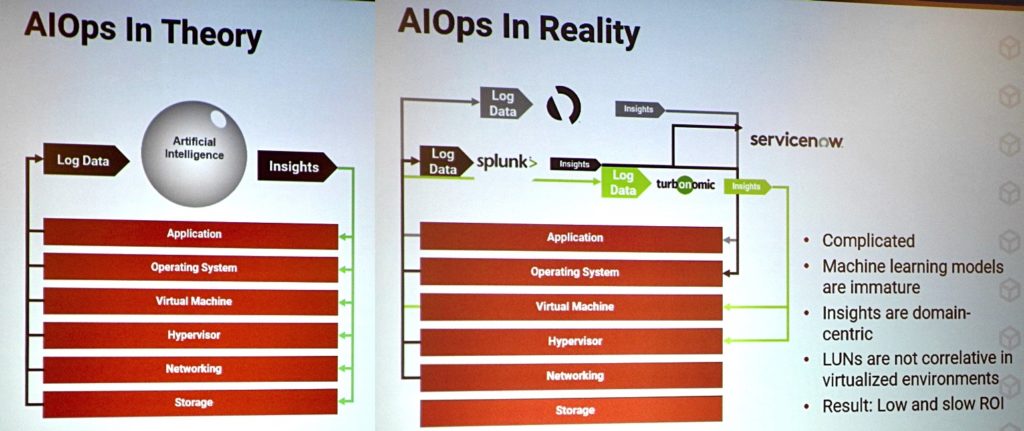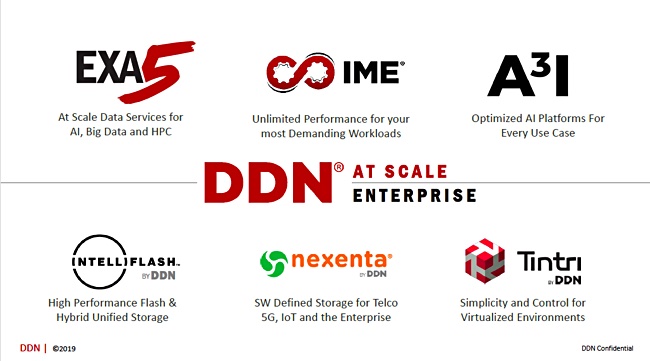DDN is organising itself into two divisions: DDN At Scale is its traditional high performance storage business; and DDN Enterprise is home to three recent acquisitions – Tintri, Nexenta and IntelliFlash. They retain their individual brands: Tintri by DDN, Nexenta by DDN and IntelliFlash by DDN.
The Enterprise division, run by GM Tom Ellery, is shaping up to be quite different from At Scale, in technology, approach and culture, as enterprise storage array supply differs from academic HPC purchasing.
In a press briefing this month, Ellery and CMO Mario Blandini ran us through the technology roadmaps. His division is developing an AIOps focus to give it a distinctive identity. This should help it make progress against the strong competition in the enterprise storage market.
DDN said the overall enterprise storage market is looking for faster access to more data that is stored in arrays which are simpler to manage and operate more efficiently than today’s products. The data will be stored in on-premises arrays and in the public cloud.
Picking up the pieces
But first a bit of scene setting. DDN’s acquisitions are a decidedly mixed bag.
Tintri went into Chapter 11 in July 2018, shortly after a disastrous IPO. DDN bought the company for $60m in a competitive auction. Last month, it said Tintri had booked $80m revs in the 12 months since acquisition, is profitable, growing and already accretive to DDN revenues.
Nexenta, a software-defined storage startup, raised $145m in 12 funding rounds since its inception in 2005. In October 2017 then CEO Tarkan Maner (now at Nutanix) said Nexenta had accumulated lifetime revenues of $100m and added he was gunning for $100m a year revenues by 2020. DDN scooped up the company in May 2019 on undisclosed terms, so we can infer Nexenta was nowhere near the $100m per year trajectory.
DDN bought Western Digital’s IntelliFlash business in September 2019 , again on undisclosed terms, when the disk drive maker decided it was not suited, after all, to run the data centre systems business it had assembled through the acquisition of Tegile in August 2017.
Now to the roadmaps.
Database-aware Tintri
Tintri’s storage is VM-aware and the company will add a SQL database-aware feature to enable the management and provisioning of database storage elements, in the same fashion as users can handle a group of VMs. This is due for release this month.
This database-aware function will be extended. As a database’s IO needs change over time Tintri OS will reconfigure resources without admin involvement to provide what the database needs within set policy limits. The admins can get real-time and historic analytics reports.
Blandini said existing array management services are based on telemetry – or log data – that is examined and analysed, using fault-fix and predictive analytics, and then given to customers. The company aims to offer real-time analysis using AI operations (AIOps) techniques to produce intelligent storage infrastructure that integrates with an overall data centre.

AIOps in theory vs. AIOps in reality
Blandini said AIOps ideally means telemetry from data centre components feeds int to an analytics intelligence function which munches the data and produces insights and actions to modify component layer items in the data centre.
The reality falls short of the ideal, with incomplete component layer log data going to different places and getting analysed in different ways. DDN aims to improve on this inadequate AIOps reality by introducing autonomous in-array functionality. (See presentation slide below.)
The AIOps software will execute in the array to provide the real-time capability and there will also be predictive analytics based on historical telemetry. Array log data is received and analysed by the array’s Tintri OS to see how the array is operating against its planned state and changes are made autonomously in real time to optimise performance.

Nexenta and IntelliFlash
The IntelliFlash arrays are positioned as high performance flash arrays while the Tintri products are for virtual server and, in the future, database environments. Nexenta’s main product, NexentaStor, is software-only and runs on commodity hardware.

NexentaStor and IntelliFlash software are both based on ZFS. Our understanding is that DDN will work to combine the two into a single environment.
This will be available as software-only to run on the IntelliFlash appliance hardware as that develops, with higher-capacity SSDs supported for example.
Some limited cross-fertilisation is happening already: there is a Nexenta VSA available for Tintri arrays, for example. Tintri is developing AIOps management functionality, while the IntelliFlash arrays come with IntelliCare cloud-based predictive analytics. This uses telemetry from the array.
We did not hear if DDN is to develop in-array AIOps capability for the IntelliFlash appliance. But Blocks & Files thinks IntelliCare will also gain a real-time AIOps function.








